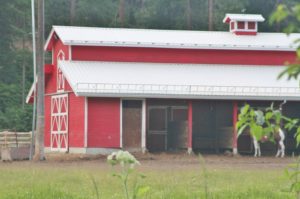Using Solar Support to Heal Compromised Hooves
by Tab Pigg
No matter the season, anytime wet conditions are present bacteria and fungus can get trapped in a horse’s hoof wall. Similar to human toenails, once fungus and bacteria have set in it’s very difficult to conquer. This combination of pathogens in the hoof wall is a recipe for White Line Disease.
The Anatomy of White Line Disease

When looking at the bottom of a horse’s hoof, there is a white line that divides the outside of the hoof wall and the sole. This part of the hoof is also known as “stratum internum,” the innermost part of the hoof wall. It attaches the wall to the underlying soft tissue. When bacteria and fungus get trapped within this area, the white line becomes wider as it separates, thus the name of this condition – White Line Disease. Depending on the severity, a horse can become lame because the infection causes the hoof wall to deteriorate.
When a hoof is already unhealthy or compromised in any way, it’s more prone to infection. Once the disease has set in, the hoof wall begins to disappear as bacteria eat away the lining. White Line Disease consists of anaerobic bacteria which thrives in conditions with little to no oxygen. If a hoof is left untreated, the infection can become more severe as it moves up the hoof wall. Eventually, the attachment to the hoof wall is eaten away completely.
Managing White Line Disease
Depending on the severity of the hoof damage, there are a few ways to manage this condition. If White Line Disease is caught early enough it can be managed with different topical treatments and exposure to oxygen. If the hoof wall is drastically eaten away there are different shoeing and booting options. If the condition is very severe re- sectioning of the hoof wall may be necessary. Similar to humans, in order for a new, healthy nail to grow in the infected nail needs to be removed. This is known as re- sectioning and in severe cases it is the last option. During this process the hoof wall is carefully removed to expose the area to oxygen which will kill the bacteria.
After a hoof wall is reset shoes cannot be nailed to hooves, but a horse still needs support. Modern solar support and pad materials can assist with not only providing support, but also sealing out moisture and debris during the healing process.

Vettec’s solar support products like Equi-Pak CS and Equi-Build help provide necessary support and also allow the hoof wall to regrow. Super Fast is a product that can be applied to help provide more support as a temporary “shoe.” Super Fast is a durable fast and hard setting urethane formula that is ideal for creating custom shoes directly on the foot when nailing is not an option. This product also allows hoof care professionals to make small hoof repairs quickly and easily. Equi-Pak CS will bond to the bottom of a horse’s foot, eliminating the possibility of further bacteria being trapped in the hoof wall. Equi-Pak CS is a fast setting, soft instant pad material and is infused with copper sulfate. This product provides extra protection and support, and also bonds to the sole. It is also an effective product for managing White Line Disease. Equi-Build is a firm pad material that distributes a horse’s weight across the entire hoof bottom to grow the heel, hoof wall and sole faster. This product also adheres to the sole, sealing out moisture and debris. Because the hoof wall is sensitive during re-growth, Equi-Build helps to take the pressure off hoof wall cracks.
Managing White Line Disease can be difficult if the condition is not caught in its early stages. Along with the diagnosis, treatment and support of a horse’s healthcare team, solar support and pour-in pad products can aid the healing process of the hoof wall. Of course, an important key to prevention and management is to eliminate wet conditions where it can flourish.
Published in November 2015 Issue
Tab Pigg is a Certified Journeyman Farrier and Farrier-at-Large for Vettec Inc., a manufacturer of innovative sole support products for horses. In his role at Vettec, Tab leads hands-on clinics throughout the U.S. to teach shoeing and forging techniques to equine owners, farriers, and veterinarians. He also visits veterinary and farrier schools exchanging information about hoof anatomy and shoeing. Tab shares his expertise via a popular video and blog series,“Two Minutes with Tab” on Vettec.com For Tab, shoeing horses is much more than a way to earn a paycheck. Helping horses and knowing that he has the ability to improve the horse’s quality of life is very valuable to him. Tab lives his own motto every day: “The education to become a farrier never ends. Anyone who feels that they have it all figured out is wrong.”






